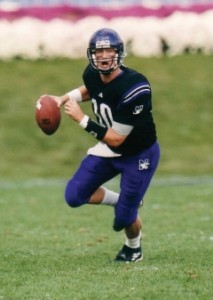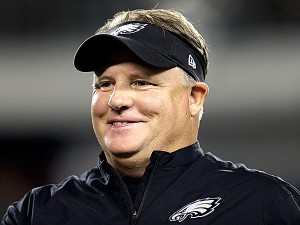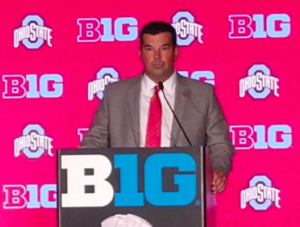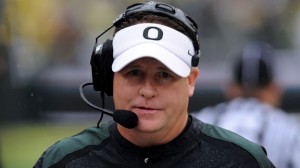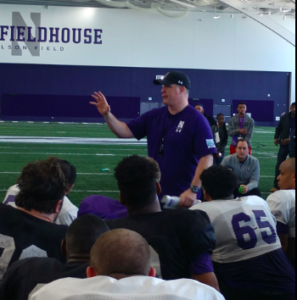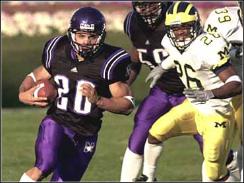As the new millenium began, the Northwestern Wildcats were at the forefront of offensive schematics in national college football. The Cats were the 2000 Big Ten co-champions (with Michigan and Purdue), thanks in large part to the spread-option system that they were running on offense.
Head Coach Randy Walker, and offensive coordinator Kevin Wilson, installed a system built around spreading defenders out, and then creating individual mismatches to potentially exploit. It was the polar opposite of the cliched “playing in a phone booth,” and it provided a signature win on Nov. 4, 2000 that was a harbinger of the brave new world to come.
That win, a 54-51 win over #12 Michigan was on national television (ABC) and it included a segment that showed Walker and Wilson’s boys doing ab work, bicycle kicks to be exact, as a means of building up their core strength/conditioning to run “the spread.”
It’s an offense designed to provide running lanes and negate one-on-ones where your side is at a physical, size disadvantage. It wasn’t long until the system spread (pun intended) across the country, but it all started at a school where the fight song literally includes the words “spread far the fame.”
Tonight, someone inspired by Walker’s team, Ohio State coach Ryan Day, joined by his offensive coordinator- the same Kevin Wilson, came to Evanston.
They led the Buckeyes into Ryan Field and the result was predictably lopsided.
Call it what you will, a “curb-stomping,” “a massacre,” “they got boat-raced,” but the result was never in doubt after the middle of the second quarter. Up 31-3 at the half, everything after the half was essentially just garbage time, and the Buckeyes won 52-3. OSU won the passing yardage battle 201-42 and total yardage 480-199.
“They’ve got weapons who can score on every play,” Northwestern coach Pat Fitzgerald said after the game. “I think they’re the best team in the country”
And looking at the whole history of all of this, it’s a tale filled with coincidence for sure, and maybe, potentially some irony.
Back in the day, a then obscure assistant coach at New Hampshire, named Chip Kelly, went and visited with the guys at NU. He brought the playbook for Day, then a quarterback, to utilize in their system.
“We used to watch all the films,” Day said.
“That was how the spread game started. We came back and called it everything that Kevin Wilson and Coach Walker and everybody called it at Northwestern.”
“That was like the way to run the spread offense. Chip went out and visited them and came back with all the different terminology, and I was like the guinea pig quarterback to try to figure it out, and some games and some plays were better than others, but that was the start of it.”
“Kevin Wilson was right on the front end of that, and so yeah, the offense that we were running there, a lot of it had to do with Northwestern.”
The spread then got trendy, from coast to coast, but Northwestern were truly cutting-edge trail blazers during the 2000s.
“There were other teams,” Day continued.
“Rich Rodriguez was at Clemson at the time, and Wake Forest had a part — there was different versions of it, but certainly Northwestern was right on the front end.”
Don’t think for a second that this style is soft though- it’s all about running the Day then articulated the philosophy behind the spread attack:
“The idea is that you’re trying to create space, especially in today’s day and age with the size of the different players that are out there, it’s become harder and harder to run between the tackles because they’re so big and strong, and the more you can get guys out in space, the better off it is.”
“You look at basketball, that’s the way they’re going.”
“It’s the same thing in football. But that doesn’t take away from the toughness and the edge that you play with and block and run with, and so having the two of those, being physical but also being able to spread teams out I think is a great combination.”
Day’s predecessor, Urban Meyer, also adopted the spread and won three national titles with it. Northwestern meanwhile kept putting exciting, high-scoring offenses on the field up until the mid 2010s. Walker’s life was tragically cut short in 2006, and his successor, Pat Fitzgerald brought a level of consistency to Evanston that they hadn’t previously seen.
Fitzgerald’s teams have only been ineligible for a bowl three times in his 13 years at the helm.
After the obliteration by Ohio State, Fitzgerald spoke of Walker bringing the Miami of Ohio offense (I-formation, power run game) over, and how when it didn’t work (NU went 3-9 his first season in 1999), he made a systemic change.
“They studied Rich-Rod, and some of the stuff they were doing at Clemson at the time, morphed it into instead of a spread to throw it into a spread to run it mentality,” said Fitzgerald.
“And we kind of morphed it through the years and kind of tried to do the same thing.”
“You look back and when it’s been pretty efficient for us we’ve been very physical at the point of attack, and having offensive balance is kind of the mindset- and then you look at the talent that Ryan has at his disposal right now.”
“You’ve got weapons that can score on every play. He’s doing a phenomenal job; great guy, tremendous football coach. I have the utmost respect for Ryan.”
NU kept the offensive machine rolling up until 2012, when it then plateaued, stagnated and declined.
Courtesy of cfbstats.com, the annual rankings in scoring, 2013-present looks like this: 83rd, 101st, 114th, 87th, 56th and 100th. For yardage, the national rankings are as follows: 84th, 122nd, 122nd, 100th, 98th, 124th.
Entering the whooping tonight, NU was 125th nationally (Rutgers is the only power five conference team that’s worse) in total offense. In scoring 128th; in passing 123rd, and remember those numbers will likely fall even further once you figure in tonight’s anemic offensive performance.
If this isn’t nadir for Northwestern, then I shudder to think what it.
That 2000 Northwestern football team was the program’s last conference champion, and it ran an offense based around Damien Anderson, who was the school’s all-time leading rusher until only a couple years ago.
Now his son, Drake Anderson, is the current team’s leading rusher, and his experience is well, the polar opposite of his dad’s. That standard setting 2000 team, and all that they accomplished just feels like ancient history right now.
College football schematics are just like most competitive marketplaces in business- if you’re standing still you are actually falling behind. Northwestern stood still for a long time, and now they’re falling further behind each season. It’s time for a reboot to the system.
Paul M. Banks runs The Sports Bank.net, which is partnered with News Now. Banks, the author of “No, I Can’t Get You Free Tickets: Lessons Learned From a Life in the Sports Media Industry,” regularly appears on WGN CLTV and co-hosts the “Let’s Get Weird, Sports” podcast on SB Nation.
You can follow Banks, a former writer for NBC Chicago.com and Chicago Tribune.com on Twitter here and his cat on Instagram at this link.
